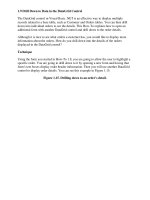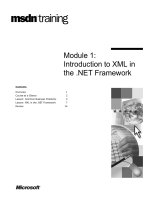253. Chicago_ Some Big Places to See in the ''''City of the Big Shoulders'''' docx
Bạn đang xem bản rút gọn của tài liệu. Xem và tải ngay bản đầy đủ của tài liệu tại đây (118.35 KB, 5 trang )
Chicago: Some Big Places to See in the 'City of the Big Shoulders'
Written by Jerilyn Watson
07 May 2006
(MUSIC)
VOICE ONE:
Welcome to THIS IS AMERICA in VOA Special English. I’m Faith Lapidus.
VOICE TWO:
And I’m Steve Ember. This week: some places to see in Chicago.
(MUSIC)
VOICE ONE:
Early last century, the poet Carl Sandburg described Chicago, Illinois, as the “City of the Big
Shoulders.” That still seems right. Chicago does a lot of things in a big way.
For example, the city is a big transportation center in the Midwest for trains,
trucks, ships and planes.
Manufacturing is one of the biggest industries in Chicago.
And Chicago has one of America’s busiest ports. The city stretches for
about forty kilometers along the southwestern shore of Lake Michigan. The
Saint Lawrence Seaway opened in nineteen fifty-nine. It connects the Great
Lakes to the Atlantic Ocean.
(MUSIC)
VOICE TWO:
Chicago is big on music. Visitors can find all kinds, from classical to hip-hop. Some of the best
places for jazz and blues are along Rush Street.
There are lots of things to see and hear in Chicago.
At the Art Institute of Chicago, people can see fine Asian art and much more.
At the Museum of Science and Industry, visitors crowd a working coal mine and a World War Two
submarine.
At the Adler Planetarium, people see stars and learn about space. And at the Shedd Aquarium, they
see colorful fish and learn about life under the sea.
VOICE ONE:
Chicago lakefront area
Not surprisingly Chicago has a lot of big buildings. The two tallest are the Sears Tower and the John
Hancock Building.
Many people take architectural tours around Chicago. There are many interesting landmarks and
building designs to see.
The Wrigley Building, near the Chicago River, opened in the early nineteen twenties. This office
building is hard to miss. It is bright white.
Downtown Chicago, the business center, is known as the Loop. There are many offices and stores.
The Loop includes the financial district around LaSalle Street. The financial district is home to the
Chicago Board of Trade, the Chicago Stock Exchange and many banks.
(MUSIC)
VOICE TWO:
Another big thing to see, and feel, is the weather. After all, another name for Chicago is the "Windy
City." People turn their shoulders to the strong winds off Lake Michigan. In winter, Chicago gets a
lot of snow; in summer, the weather is hot and sticky.
Almost three million people live in Chicago. Chicago is America's third largest city, after New York
and Los Angeles. More than nine million people live in surrounding communities.
Over the years many immigrants have settled in Chicago. Many of its people have ethnic roots in
Poland, Germany, Ireland and Italy. More recent immigrants have come from all over the world.
Today just under half the population of the city of Chicago is non-Hispanic white. The city has large
black and Hispanic populations. Four percent of the people are Asian.
VOICE ONE:
When people in Chicago want to be outdoors, one place to go is
Millennium Park. In this City of Big Shoulders, almost everything about
Millennium Park is big. It covers ten hectares. It took almost nine years
to finish.
Millennium Park is on Michigan Avenue near Lake Michigan. It
officially opened in two thousand four. It cost four hundred seventy-five
million dollars.
Millennium Park has gardens and places for music, dance and ice skating. It also has one of the
largest outdoor sculptures in the world. Anish Kapoor of Britain created this work of public art. It
weighs one hundred ten tons.
A huge rounded form of shiny steel captures a looking-glass image of the Chicago skyline and the
clouds above. The sculpture is called “Cloud Gate.”
VOICE TWO:
Millennium Park
The Spanish artist Jaume Plensa designed the Crown Fountain in Millennium Park. The fountain is
surely one of the most unusual in the world.
The artist set a pool of water between two tall glass towers. Video images appear on the towers. The
images are a series of pictures of nature and people’s faces. The water appears to pour from their
mouths. The faces represent the many different people of Chicago.
VOICE ONE:
Millennium Park has music in the Jay Pritzker Pavilion. The architect Frank Gehry designed this
modern-looking structure. It can seat four thousand people under its open-top steel ribbons. There is
also an area called the Great Lawn to listen to the music. The sound system makes the music seem
like it is coming from inside a concert hall.
The pavilion is a home for the Grant Park Music Festival. Listen as the Grant Park Symphony plays
“Julius Caesar: Symphonic Epilogue After Shakespeare," Opus Twenty-eight, composed by Robert
Kurka.
(MUSIC)
VOICE TWO:
In warm weather, people eat outdoors in the McCormick
Tribune Plaza and Ice Rink in Millennium Park. In winter,
skaters come out to enjoy the ice.
Visitors can also walk and ride bicycles in several areas of the
plaza.
An indoor space has room for three hundred bicycles. There are also places where people who ride
their bikes to work can clean up and change clothes.
Another part of Millennium Park is the Lurie Garden. This one-hectare area is bordered by what is
called the "Shoulder Hedge." Trees almost five meters tall form a living wall around the garden.
"Shoulder" in this case is meant to honor the poet Carl Sandburg. One hundred thirty-eight kinds of
plants grow in the Lurie Garden.
VOICE ONE:
Many people enjoy the activities at Millennium Park. But critics wonder why the city needed a park
so big and costly. They say the city should have spent the money instead on its more than six hundred
public schools. They say it could have helped the poor.
Twenty-one percent of people in the city of Chicago were living below the poverty level in two
thousand four. The official poverty rate nationally that year was about thirteen percent.
VOICE TWO:
McCormick Place
Other people say Millennium Park has improved the appearance of the area where it was built. The
mayor and many other city leaders believed a big park would bring more
people, more homes and more businesses to the area.
Mayor Richard M. Daley is the son of former Chicago mayor Richard J.
Daley. The father is still remembered for his control over the local
Democratic Party organization. The city has not elected a Republican
mayor since nineteen fifteen.
(MUSIC)
VOICE ONE:
Another big development, the Chicago Cultural Center, stands across Michigan Avenue from
Millennium Park. It contains the city's official Visitor Information Center. It is also a showplace for
the arts.
The building that now houses the cultural center was completed in eighteen ninety-seven. It held the
first permanent collection of the Chicago Public Library. It served as library headquarters until
nineteen ninety-one.
There are white walls made of marble from Carrara, Italy. And there are two Tiffany domes. The
bigger dome is one of the largest Tiffany designs in the world. It rises almost twelve meters above the
floor.
People say the restored Chicago Cultural Center looks like a home for kings and queens. Some call it
“the People’s Palace.”
VOICE TWO:
Visitors can listen to all kinds of music at the Chicago Cultural Center. For example, Monday through
Friday, there are free LunchBreak Concerts. Listen now to Middle Eastern music performed by
Safwan Matni, a popular LunchBreak Concert guest artist.
(MUSIC)
Dancers from Hubbard Street Two in Chicago have also performed at the Cultural Center. Hubbard
Street Two is a six-member dance group. It trains promising dancers between the ages of seventeen
and twenty-five. They perform works by young choreographers.
VOICE ONE:
Carl Sandburg would probably not have been surprised by big projects like the Chicago Cultural
Center and Millennium Park. The poet wrote: “Come and show me another city with lifted head
singing so proud to be alive … ”
(MUSIC)
VOICE TWO:
Our program was written by Jerilyn Watson and produced by Caty Weaver. I’m Steve Ember.
Mayor Richard M. Daley
VOICE ONE:
And I’m Faith Lapidus. Read and listen to our programs at voaspecialenglish.com. And join us again
next week for THIS IS AMERICA in VOA Special English. We leave you with Frank Sinatra singing
about "My Kind of Town."
(MUSIC)









